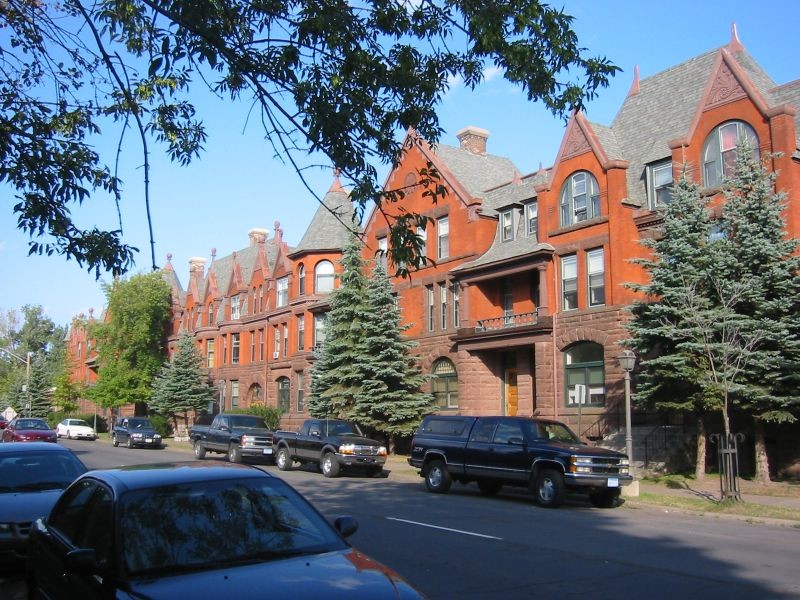Chester Terrace
Introduction
Text-to-speech Audio
Images
Chester Terrace Apartments in Duluth

Backstory and Context
Text-to-speech Audio
Chester Terrace is a noteworthy example of Romanesque Revival row house design in Duluth, designed by the acclaimed late nineteenth-century architects, Oliver Traphagen and Francis Fitzpatrick. Traphagen and Fitzpatrick designed more than fifty buildings in Duluth, most of which exhibit characteristics associated with either the Romanesque or the Medieval style. Chester Terrace stand as one of two examples of row house designs executed by the team. Chester Terrace functioned as a rental house, which points to a tremendous population and building boom in Duluth tied to the rapid development of mining and milling industries. The population soared from nearly 3,500 people in 1880 to more than 50,000 people by 1900.
Slowly but surely from roughly the 1830s to the 1860s, migrating Americans and immigrating Europeans displaced native Ojibew inhabitants on the shores of Lake Superior in what is now Duluth, Minnesota. By the 1850s, miners flocked to Duluth looking for gold or copper, which eventually led to the discovery of plentiful iron ore and the resultant mining thereof. Additionally, as people moved to Duluth during the 1850s and 1860s, the extensive forests near Duluth piqued speculators' interests who sought to invest in lumber (timber).
The combination of mining and timber (and saw milling) pushed leaders to develop more canals, invite railroads to extend tracks into the city, and develop ports on Lake Superior. With enhanced transportation came greater economic success for Duluth during the 1870s. A thriving grain trade (and the concurrent emergence of flour milling) emerged, and because a need arose for coal to keep the industries running and people heated in the cold city, Duluth grew into a meaningful coal distribution center. The rapid development of milling, mining, and factories led to an influx of unskilled labor (usually poor immigrants), many of whom lived in shanties.
Along with laborers, plenty of skilled workers, professionals, and other residents "with means" arrived in Duluth during the late nineteenth century. Indeed, the town experienced more than an 850% increase in population during the 1870s. However, despite the abundance of nearby timber, residential housing construction lagged behind commercial development and the demand required by such an explosive population boom. Indeed, it wasn't until the 1880s and 1890s that housing proved adequate, leading to such projects as the Chester Terrace rental property, an excellent example of property catered to the middle class. Chester Terrace survives today as a reminder of the 1890s building boom that resulted in a densely populated downtown Duluth.
The three-story, brick Chester Terrace consisted of twenty-five residential units ranging from one-bedroom apartments to 2800 square foot townhouses when it opened in 1890. The exterior enjoys distinctive ornamentation, such as towers, turrets, pinnacles, and gables. The building name comes from the neighboring Chester Creek that flows into Lake Superior. The exterior has remained almost entirely unaltered from its 1890 appearance, and the building continues to function as an apartment complex.
Sources
Hudelson, Richard and Carl Ross. By the Ore Docks: A Working People's History of Duluth. United States: University of Minnesota Press, 2006.
King, Franklin A. "Logging Railroads of Northern Minnesota." The Railway and Locomotive Historical Society Bulletin, no. 93 (1955): 94-115. Accessed July 29, 2020. www.jstor.org/stable/43517794.
Newberg, Dale S. and Charles W. Nelson. "Nomination Form: Chester Terrace Apartments." National Register of Historic Places. nps.gov. November, 1980. https://npgallery.nps.gov/GetAsset/60bfdba2-de8a-4cb3-9b91-e9efcfa99a5c
Norton, Maryanne C. and Sheldon T. Aubut. Duluth, Minnesota. Mount Pleasant, SC: Arcadia, 2001.
Pardee, John Stone and Dwight Edwards Woodbridge. History of Duluth and St. Louis County, Past and Present. United States: C.F. Cooper, 1910.
By Todd Murray from Bloomington, MN, USA - Chester Terrace 1, CC BY-SA 2.0, https://commons.wikimedia.org/w/index.php?curid=2578752
